仅用于记录在分析netty源码的日志
源码调用关系图

Netty Server示例
EventLoopGroup boss = new NioEventLoopGroup(1);
EventLoopGroup io = new NioEventLoopGroup();
ServerBootstrap bootstrap = new ServerBootstrap();
bootstrap.group(boss, io);
bootstrap.channel(NioServerSocketChannel.class).childHandler(new ChannelInitializer<NioSocketChannel>() {
@Override
protected void initChannel(NioSocketChannel ch) throws Exception {
}
});
bootstrap.bind(25001).sync().addListener(new ChannelFutureListener() {
@Override
public void operationComplete(ChannelFuture future) throws Exception {
if (future.isSuccess()) {
System.out.println("启动成功");
} else {
future.cause().printStackTrace();
}
}
});
代码执行到bootstrap.bind(25001)时,netty内部的绑定端口如下:
AbstractBootstrap --> bind() --> doBind() --> doBind0()- NioServerSocketChannel的bind方法在父类AbstractChannel类,所以channel的调用关系:
AbstractChannel --> bind() DefaultChannelPipeline --> bind()AbstractChannelHandlerContext --> bind()HeadContext --> bind()AbstractChannel.AbstractUnsafe --> bind(),然后调用AbstractChannel --> doBind(),而他的实现类看下一步NioServerSocketChannel --> doBind()